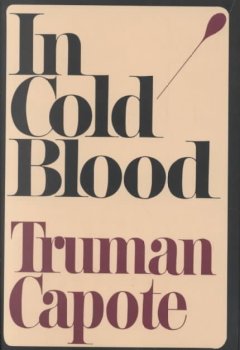
If you spend your Friday nights watching Dateline or your morning commutes listening to podcasts like My Favorite Murder or The Last Podcast on the Left, you're probably a true crime fan! If you haven't read much true crime but love investigations and are curious about the human mind, here are some good places to start. There's a mix of the classic like In Cold Blood and Helter Skelter, to recent titles like Murder in the Bayou and the Notorious Mrs. Clem, so there is something for everyone interested in true crime.
|
|
In cold blood: a true account of a multiple murder and it's consequences by Truman Capote: On November 15, 1959, in the small town of Holcomb, Kansas, four members of the Clutter family were savagely murdered by blasts from a shotgun held a few inches from their faces. There was no apparent motive for the crime, and there were almost no clues.
As Truman Capote reconstructs the murder and the investigation that led to the capture, trial, and execution of the killers, he generates both mesmerizing suspense and astonishing empathy. In Cold Blood is a work that transcends its moment, yielding poignant insights into the nature of American violence. |
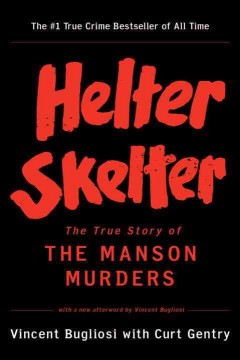 |
Helter Skelter: the true story of the Manson murders by Vincent Bugliosi: Prosecuting attorney in the Manson trial, Vincent Bugliosi held a unique insider's position in one of the most baffling and horrifying cases of the twentieth century: the cold-blooded Tate-LaBianca murders carried out by Charles Manson and four of his followers. What motivated Manson in his seemingly mindless selection of victims, and what was his hold over the young women who obeyed his orders? Here is the gripping story of this famous and haunting crime. |
 |
My friend Dahmer by Derf Backderf: You only think you know this story. In 1991, Jeffrey Dahmer, the most notorious serial killer since Jack the Ripper, seared himself into the American consciousness. To the public, Dahmer was a monster who committed unthinkable atrocities. To Derf Backderf, 'Jeff' was a much more complex figure: a high school friend with whom he had shared classrooms, hallways, and car rides. In [this story], a haunting and original graphic novel, writer-artist Backderf creates a surprisingly sympathetic portrait of a disturbed young man struggling against the morbid urges emanating from the deep recesses of his psyche-- a shy kid, a teenage alcoholic, and a goofball who never quite fit in with his classmates. With profound insight, what emerges is a Jeffrey Dahmer that few ever really knew, and one readers will never forget. |
 |
The stranger beside me by Ann Rule: Ann Rule was a writer working on the biggest story of her life, tracking down a brutal mass-murderer. Little did she know that Ted Bundy, her close friend, was the savage slayer she was hunting. |
 |
Party Monster: a fabulous but true tale of murder in Clubland by James St. James: When Disco Bloodbath was first published, it created a storm of controversy for its startlingly vivid, strikingly fresh, and outrageously funny depiction of the hedonistic world of the New York City club kids, for whom nothing was too outré -- including murder. Nominated for the Edgar Award for best true-crime book of the year, it also marked the debut of an audaciously talented writer, James St. James, who himself had been a club kid and close friend and confidant of Michael Alig, the young man convicted of killing the drug dealer known as Angel. |
 |
Columbine by Dave Cullen: On April 20, 1999, two boys left an indelible stamp on the American psyche. Their goal was simple: to blow up their school, Oklahoma-City style, and to leave "a lasting impression on the world." Their bombs failed, but the ensuing shooting defined a new era of school violence—irrevocably branding every subsequent shooting "another Columbine." When we think of Columbine, we think of the Trench Coat Mafia; we think of Cassie Bernall, the girl we thought professed her faith before she was shot; and we think of the boy pulling himself out of a school window—with the whole world watching him. In this riveting piece of journalism nearly ten years in the making comes the story none of us knew. This revelatory book offers a profile of teenage killers that goes to the heart of psychopathology. Dave Cullen, the acclaimed journalist who followed the massacre from day one, lays bare the callous brutality of mastermind Eric Harris and the quavering, suicidal Dylan Klebold, who went to prom three days earlier and obsessed about love in his journal. The result is an astonishing account of two good students with lots of friends, who came to stockpile a basement cache of weapons, to record their raging hatred, and to manipulate every adult who got in their way. |
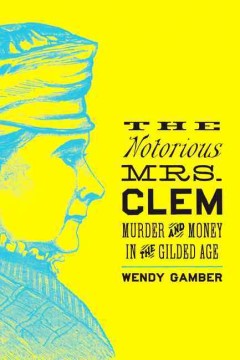 |
The Notorious Mrs. Clem: murder and money in the Gilded Age by Wendy Gamber: In September 1868, the remains of Jacob and Nancy Jane Young were found lying near the banks of Indiana's White River. It was a gruesome scene. Suspicion for both deaths turned to Nancy Clem, a housewife who was also one of Mr. Young's former business partners. In The Notorious Mrs. Clem, Wendy Gamber chronicles the life and times of this charming and persuasive Gilded Age confidence woman, who became famous not only as an accused murderess but also as an itinerant peddler of patent medicine and the supposed originator of the Ponzi scheme. Clem's story is a shocking tale of friendship and betrayal, crime and punishment, courtroom drama and partisan politicking, get-rich-quick schemes and shady business deals. It also raises fascinating questions about women's place in an evolving urban economy. As they argued over Clem's guilt or innocence, lawyers, jurors, and ordinary citizens pondered competing ideas about gender, money, and marriage. Based on extensive sources, including newspapers, trial documents, and local histories, this gripping account of a seemingly typical woman who achieved extraordinary notoriety will appeal to true crime lovers and historians alike. |
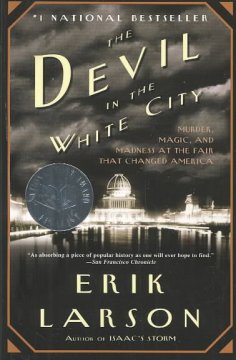 |
The Devil in the White City: murder, magic, and madness at the fair that changed America by Erik Larson: Two men, each handsome and unusually adept at his work, embodied an element of the great dynamic that characterized America's rush toward the twentieth century. Daniel Hudson Burnham, a renowned architect, was the brilliant director of works for the 1893 Chicago World's Fair. Henry H. Holmes, a young doctor, was the satanic murderer of scores of young women in a torture palace built for the purpose near the fairgrounds. Burnham overcame great obstacles to build his White City; Holmes used the attraction to lure women to their deaths. |
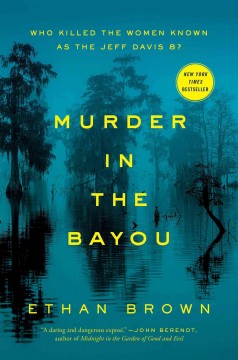 |
Murder in the Bayou: who killed the women known as the Jeff Davis 8? by Ethan Brown: Between 2005 and 2009, the bodies of eight women were discovered around the town of Jennings, in Jefferson Davis Parish, Louisiana. They had all engaged in sex work as a means of survival, and they came to be called the Jeff Davis 8. The investigations into their deaths, originally searching for a serial killer, raised questions about police misconduct and corruption. |
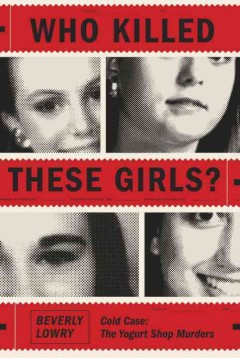 |
Who killed these girls? : the yogurt shop murders by Beverly Lowry: From the author of Crossed Over, another masterful account of a horrible crime: the murder of four girls, countless other ruined lives, and the evolving complications of the justice system that frustrated the massive attempts--for twenty-five years now--to find and punish those who committed it. The facts are brutally straightforward. On December 6, 1991, the naked, bound-and-gagged bodies of the four girls--each one shot in the head--were found in an I Can't Believe It's Yogurt! shop in Austin, Texas. Grief, shock, and horror spread out from their families and friends to overtake the city itself. Though all branches of law enforcement were brought to bear, the investigation was often misdirected and after eight years only two men (then teenagers) were tried; moreover, their subsequent convictions were eventually overturned, and Austin PD detectives are still working on what is now a very cold case. Over the decades, the story has grown to include DNA technology, false confessions, and other developments facing crime and punishment in contemporary life. But this story belongs to the scores of people involved, and from them Lowry has fashioned a riveting saga that reads like a Russian novel, comprehensive and thoroughly engrossingin col. |

